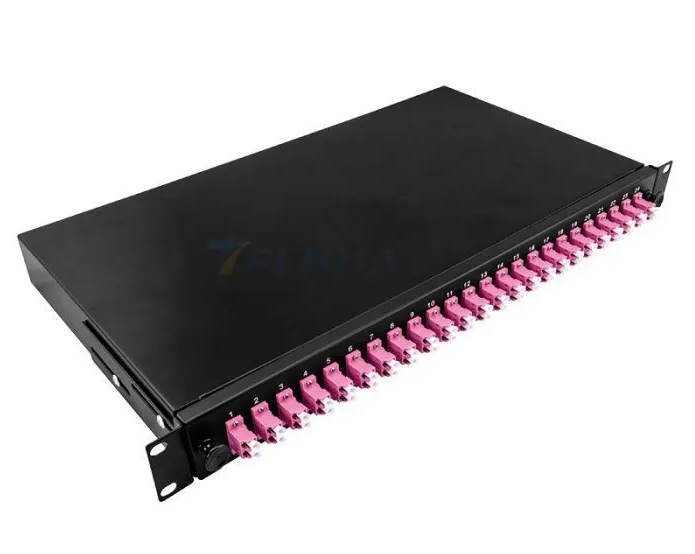Efficient Fiber Optic Connectivity with 48 Port MTP Patch Panel and LC-MTP Multimode OM4

Enhancing Fiber Optic Connectivity
Fiber Optic Termination
To ensure efficient fiber optic connectivity, the implementation of a 48 port MTP patch panel with LC-MTP multimode OM4 is essential. This setup allows for seamless and high-performance data transmission, catering to the increasing demands of modern networking environments.
Best Practices
Utilizing best practices for fiber termination methods guarantees optimal performance and reliability in fiber optic networks. By adhering to industry standards and employing precision in termination processes, organizations can achieve enhanced connectivity and minimize potential disruptions.
Termination Methods
Fiber Optic Termination
When it comes to fiber optic termination, various techniques are employed to ensure the seamless and efficient connection of fiber optic cables. The process involves carefully aligning and fusing the fibers within the cable to guarantee minimal signal loss and optimal performance. Understanding the intricacies of fiber optic termination is crucial for maintaining high-speed data transmission and reliable network connectivity.
Fiber termination involves precise handling of delicate optical fibers, necessitating expertise and attention to detail. Whether it's fusion splicing, mechanical splicing, or connectorization, each method plays a vital role in establishing robust connections within fiber optic networks. By comprehending the nuances of these termination techniques, organizations can effectively maintain their fiber infrastructure and uphold consistent data transfer capabilities.
Best Practices
Implementing best practices for fiber termination methods is imperative for ensuring the longevity and reliability of fiber optic networks. Adhering to industry standards, utilizing high-quality components, and conducting thorough testing are essential steps in achieving optimal connectivity. Additionally, employing skilled professionals with expertise in fiber termination techniques contributes to the overall efficiency and performance of the network infrastructure.
By prioritizing meticulous attention to detail and precision in termination processes, organizations can minimize signal degradation and potential points of failure within their fiber optic systems. This commitment to best practices ultimately results in sustained high-performance connectivity that meets the demands of modern networking environments.
OM4 Fiber Cable
OM4 Specifications
When it comes to OM4 fiber cable, understanding its specifications is pivotal for ensuring efficient fiber optic connectivity. OM4, which stands for "Optical Multimode 4," is designed to support high-speed data transmission over extended distances within data centers and enterprise networks.
One of the key specifications of multimode OM4 fiber is its ability to accommodate higher bandwidths compared to its predecessors. With a larger core size and enhanced refractive index profile, OM4 optical fiber enables the seamless transmission of data at speeds of up to 10 gigabits per second and beyond.
Moreover, OM4 fiber cable is engineered with precision to minimize modal dispersion, allowing for the efficient propagation of light signals across the network. This characteristic ensures that data travels reliably and consistently, meeting the demands of modern networking environments.
Understanding these specifications empowers organizations to make informed decisions regarding their fiber optic connectivity infrastructure. By leveraging the capabilities of OM4 fiber cable, businesses can optimize their network performance and cater to increasing data transmission requirements.
Benefits of OM4
The deployment of OM4 fiber cable offers a multitude of benefits for fiber optic connectivity. Its enhanced bandwidth capabilities provide ample support for high-speed data transfer, making it ideal for applications requiring robust network performance.
Furthermore, the reliability and consistency provided by OM4 optical fiber contribute to seamless connectivity within data centers and enterprise networks. The ability to transmit data over extended distances without compromising performance makes OM4 an optimal choice for organizations seeking dependable network infrastructure.
Additionally, the longevity and versatility of OM4 fiber cable ensure that businesses can future-proof their network investments. As technology continues to advance, OM4's capacity to support higher transmission speeds positions organizations to adapt to evolving connectivity requirements without overhauling their existing infrastructure.
Incorporating these benefits into network planning and deployment strategies allows businesses to achieve sustainable growth while maintaining a competitive edge in today's digital landscape.
LC-MTP Connectivity
LC-MTP Connector
In the realm of fiber optic connectivity, the LC-MTP connector plays a pivotal role in facilitating efficient data transmission. This connector is specifically designed to seamlessly integrate with LC and MTP interfaces, providing a reliable and high-performance connection between fiber optic cables.
The compatibility of the LC-MTP connector with multimode OM4 fiber cable ensures that organizations can leverage its capabilities for high-speed data transfer. Its compact form factor and robust design make it ideal for dense network environments where space optimization is crucial.
Furthermore, the LC-MTP connector's ability to support high-density applications enhances its versatility, allowing for the efficient management of multiple fiber connections within networking infrastructure. This feature is particularly valuable in data centers and enterprise networks where scalability and flexibility are essential.
By understanding the benefits and compatibility of the LC-MTP connector, organizations can make informed decisions regarding their fiber optic connectivity infrastructure. Leveraging this connector enables businesses to achieve seamless and reliable data transmission while optimizing their network resources.
Installation Best Practices
Implementing best practices for LC-MTP connectivity is vital to ensuring seamless fiber optic connectivity within networking environments. Some best practices include:
Adhering to industry standards during installation
Conducting thorough testing post-installation
Ensuring proper cleaning and maintenance of connectors
Labeling and organizing connections for easy management
By following these best practices, organizations can maintain optimal performance and reliability in their fiber optic networks, ultimately meeting the demands of modern networking environments while minimizing potential disruptions.
Seamless Connectivity
Achieving Seamless Fiber Optic Connectivity
The integration of 48 port MTP patch panels with LC-MTP multimode OM4 ensures a seamless and efficient fiber optic connectivity infrastructure. By leveraging these advanced components, organizations can establish robust and reliable connections for high-speed data transmission within their networks. This comprehensive approach to fiber connectivity not only enhances the performance of data centers and enterprise networks but also ensures consistent and uninterrupted optical fiber connectivity, meeting the demands of modern networking environments.
See Also
Attaining Efficient and Affordable Fiber Optic Performance
Discovering Advantages of the 960 Core Fiber Optic Splice Enclosure
Advantages of Weatherproof FastConnect Fiber Field Assembly Connector
Durable Outdoor Solution: Waterproof FTTA Patch Cord by OptiTap
Grasping the Revolutionary FTTR Invisible Fiber Cable Solution


